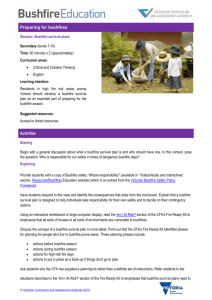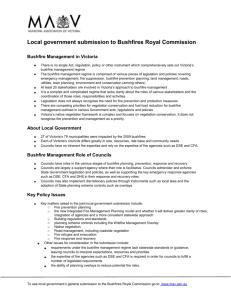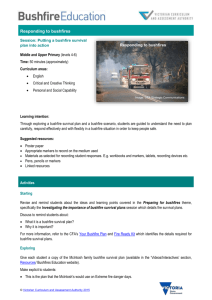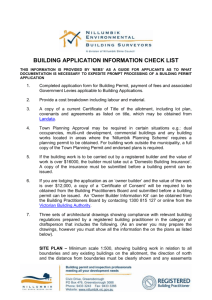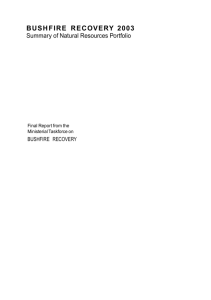Resource to Risk Assessment Summary Sheet - BFB only
advertisement
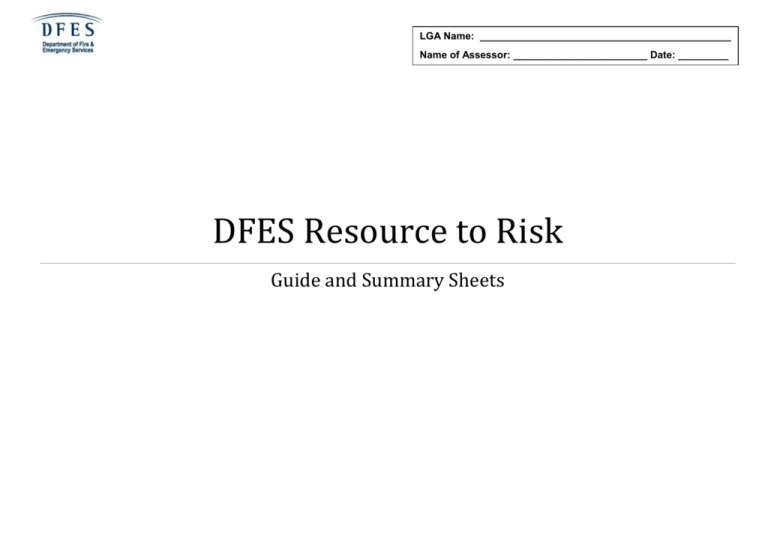
LGA Name: _____________________________________________ Name of Assessor: ________________________ Date: _________ DFES Resource to Risk Guide and Summary Sheets Resource to Risk Summary Guide to using the DFES R2R Process and Summary Sheets The R2R Process should be conducted every three years (more often if significant changes occur) for each Local Government Authority. Ideally, this exercise should be scheduled so that it can be attended by the LGA officer responsible for community emergency management coordination (CFM, CESM or similar), DFES District Manager and any other significant contributors. The R2R assessment is a useful process for considering the strengths and opportunities that exist in and around a community, as well as revealing threats and weaknesses through risk assessment, analysis and treatments. The R2R process is one where fair distribution and strategic placement of regional resources are considered as the primary consideration, with an emphasis on partnership and shared support among and between communities. The DFES Superindendent will be responsible for making prioritised and evidence-based recommendations to the ESL Capital Grants Committee, based on the collective R2R assessments across the region. The R2R is not intended to be a comprehensive catalogue of all resources or risks in an LGA. It is a process that develops a management plan for an identified risk that is currently considered to be inadequately treated. The information generated by the process should provide a firm foundation for a request for resources to the ESL Grants Committee. Stage 1 1. 2. 3. 4. 5. Stage 2 Stage 3 Bushfire Risk and Coverage –Obtain and analyse the Bushfire Threat Analysis (BFTA) maps from Bush Fire & Environmental Protection, Research & Liaison. Print out the isochrone maps for the area being analysed (maps available through DFES District Managers at http://extranet/sites/volunteers/members/GIS/Pages/TravelTimeMapping.aspx). To get a complete picture, it may be necessary to also print out adjoining areas’ isochrone maps and confirm the accuracy of the locations of existing BFS appliances on the maps1. Identify at-risk populated locations and/or critical infrastructure that appear to be lacking in adequate cover and note on Stage 1 sheet. LGRC -Identify at-risk bushfire areas with vulnerable populations using the attached LOCAL GOVERNMENT RESPONSE CRITERIA (Table 2). Document briefly on the Stage 1 sheet. Incident History -Map out and mark the number and extent of actual level 1 and level 2 bushfire incidents in the immediate vicinity attended or experienced in past 3 years and/or 5 years (if 5 years is significantly different from 3 year profile). Use Westplan –Bushfire to determine level and FIRS to supply latest data. Brigade Profile(s)- Identify risks (if any) inherent in the local BFB Brigades. Consider training, available personnel, travel time, abilities/ages of volunteers. Available Resources -List available resources, e.g. volunteers, appliances, tankers, low loaders and graders. etc. Identify whether there are additional resources available elsewhere that may assist during high-risk periods. Document potential impact of each. With the information provide by Stage 1, use Table 4 to identify risk levels for the communities and/or areas considered at- risk. If Risk Level is 6 or above, consider options for risk reduction/treatment in Stage 3. Prioritised Risk Areas Briefly state the nature of the risk and the area/population affected. Risk Reduction/Controls Consider potential methods for risk reduction in general (fuel load management, education, resources available nearby, different appliance, etc.). Is there water carrier capacity available in the vicinity? Consider DEC, private contractors, etc. Identify and document. Document methods considered, potential impact of each, ability of implementing these controls and intent to employ each method. The person responsible for the implementation should be identified in the final column. Potential Efficiencies Is there an opportunity or need to combine/collocate any units? Could swapping appliances with another area improve response abilities? Discuss and identify this, including implications. Stage 4 Review the high risk communities and/or areas identified in Stage 3. Document the new Level of Risk following the introduction of the strategies and processes identified in Stage 2 and detailed on the Risk Treatment Schedule. If Risk Level remains at 6 or above, document controls and treatments for implementation and calculate new Level of Risk. Stage 5 1 Identify additional resources required to provide minimum level of protection to the community in case of Level 1 incident and prioritise. If additional resources are outside the ability of the LGA to source locally e.g. BA, Appliance, Building, then document on ESL Grant Request form. Consider appliance type most suitable to meet Level 1 fire response criteria (see Table 1) and available trained personnel and infrastructure (has Breathing Apparatus, if identified, met criteria in Table 3)? Ensure the attached R2R Summary identifies the at-risk population and geographical area and provides supporting information for alternative controls and treatments considered. Attach BFS isochrone map(s) identifying the area concerned. Identify consequence of not obtaining capital articles on ESL Grant Request form and describe what interim measures are/will be put in place to minimise risk. Refer to Fit for Purpose assessments for identified building replacement priorities and include in ESL Grant Request form. In some areas the data is missing or outdated. Please contact GIS in Perth to update this information, preferably with coordinates from a GPS device. The updated map should be available within 2 weeks. Resource to Risk Summary Scope: The assessment will address the risks to the local community of fires in areas outside gazetted fire districts and consider the possible impacts to the people and infrastructure. Bushfires to be considered for treatment are Level 1 (although incident data on previous Level 2 and 3 bushfires should be included). Stage 1- Risk Assessment Process Method 1. 2. Bushfire Risk Areas that may have inadequate cover to protect life and property (use BFTA maps and Travel Time maps to assist with identification of these locations) Local Government Response Criteria 3. Incident History 4. Brigade Profile 5. Available Resources Notes Resource to Risk Summary Stage 2- Communities or areas with Risk Levels at 6 or more Community/Area Name Likelihood 1-5 Consequence 1-5 Level of Risk (Likelihood x Consequence) Stage 3- Risk Controls and Treatment Schedule Prioritised Risk Statements Risk Controls/ Options (e.g. Fuel reduction strategies, Strengthen volunteers capacity, Regional Water Tanker Capacity , Partnership formation, Potential Efficiencies) 1. 2. 3. Impact (High/ Med/Low) Feasibility (high/ med/low) Adopt? (Y/N) Responsible Person/Position and date(s) of implementation Resource to Risk Summary Stage 4- Revised Risk Profiles with Proposed Controls and Treatments Community/Area Name Proposed Controls (not including major additional ESL resources) Likelihood 1-5 Consequence 1-5 Level of Risk (Likelihood x Consequence) Local Government CEO: _____________________________ Signature: __________________________________ Date: ____________________________ DFES Superintendent: _______________________________ Signature: __________________________________ Date: ____________________________ Once completed, please forward a copy of this form to the DFES Planning & ESL Allocation Branch (retain a copy for your records). Resource to Risk Summary Tables TABLE 1 - APPLIANCE TYPES POPULATION CENTRE Scattered Settlement (up to 500 residents) Rural Centre or Outer Urban CHARACTERISTICS □ □ □ □ □ □ □ □ □ □ □ □ □ □ APPLIANCE TYPES Individual homes and out buildings Situated between settlements or rural centres Government Services at settlements and rural centres COMMENTS Rural Series LT, R1.4, R2.4, R4.4 Broadacre Little public infrastructure on properties Bushfire risk Larger Tanker Capacity should be considered in support of settlements Clusters of homes and buildings in central location Basic infrastructure for day to day living School/Store and supply facility Bushfire risk Large clusters of homes and buildings Infrastructure in place for limited business support Shopping sites, welfare facilities, school, medical service Urban Series 2.4 U 3.4 U Additional Light Tanker support for urban bushfire interaction to be justified Breathing Apparatus only as per assessment Major roads and airfield, Light Industrial area Bushfire risk, some complex structures Table 2 - LOCAL GOVERNMENT RESPONSE CRITERIA LOCAL GOVERNMENT RESPONSE CRITERIA KEY= *Property under threat from bushfire # Turnout time to incident. + Aircraft and/or appropriate machinery where required PASTORAL RURAL / BROADACRE SOUTH WEST AGRICULTURAL or CENTRAL WEST COASTAL LOWER WEST COASTAL Firefighting response for bushfire within 3 hours (200 + kms between services) + Firefighting response on site for property threat within 3 hours* Specialist Units (ICV) on site within 2 days Up to two fire fighting appliances on site for bushfire in 1 hour (30 + kms between services)# 1 fire firefighting appliance on site for property threat in 1 hour Specialist Units (ICV) on site within 6 hours Up to 6 fire fighting appliances on site for bushfire in 30 minutes (20kms between services) # 1 fire fighting appliance on site for property threat in 30 minutes Specialist Units (ICV) on site within 3 hours Initial dispatch of 2 fire fighting appliances on site for bushfire in 20 minutes (10 kms between services). 1 fire fighting appliance on site for property threat in 20 minutes Specialist Units (ICV) on site within 1 hour, Perth Outer Metropolitan within 45 minutes Resource to Risk Summary TABLE 3- BREATHING APPARATUS CHECKLISTS BREATHING APPARATUS ALLOCATION CRITERIA (PLEASE TICK) Appliance: Urban Series U2.4/3.4 Town Characteristics: □ □ □ □ □ □ □ □ □ □ □ □ Population - 700 or more; More than 300 houses; A hospital and/or some aged care facilities; More than 5 public buildings; Industrial area(s) with heavy industry capacity and more than 5 sites; Fuel storage areas and or petrol stations; 5 or more sites storing hazardous chemicals; One or more schools with at least 100 pupils; A number of retail shops or outlets; BREATHING APPARATUS PREREQUISITES (PLEASE TICK) □ □ □ □ □ □ □ □ □ Brigade and Local Government register agreement to provide service Brigade has an appropriate urban appliance Brigade has demonstrated a 24/7 roster with a minimum 4 person turn out Station has appropriate BA maintenance and cleaning facilities Brigade members willing to meet fitness requirements and facial hair management Brigade members trained to fire-fighter (1-12) Brigade members trained in hot fire Brigade members trained in oxygen resuscitation techniques Brigade members trained to Breathing Apparatus *requires issuing of - level 2 PPE, BA, Oxy Viva Office or other commercial developments; and An airport, a port facility or large transport depot or facilities; No breathing apparatus support within approximately 30 minutes on request TABLE 4 - LIKELIHOOD AND CONSEQUENCES – (EMERGENCY MANAGEMENT AUSTRALIA 2004) LIKELIHOOD Rare Unlikely Moderate Likely Almost Certain 1 2 3 4 5 Less than once in 15 years At least once in 10 years At least once in 3 years At least once per year More than once per year CONSEQUENCE - HUMAN LIFE AND PROPERTY 1. Insignificant or of little significance 2. Minor – No fatalities. Small number of minor injuries. First aid treatment may be required. No people are displaced. Little or no personal support required (support not monetary or material). Inconsequential or no damage 3. Moderate- Medical treatment required but no fatalities. Some hospitalisation. Localised displacement of people who return within 24 hours. Personal support satisfied through local arrangements. Local damage, rectified by routine arrangements. Community functioning with some inconvenience. 4. Major – Possible fatalities. Extensive injuries, significant hospitalisation. Large number displaced (more than 24 hours duration). Extensive resources required for personal support. Significant damage that requires external resources. Community only partially functioning, some services unavailable. 5. Catastrophic – Significant fatalities. Large number of severe injuries. Extended and large number requiring hospitalisation. General and widespread displacement for extended duration. Extensive damage. Extensive personal support. Community unable to function without significant support. Resource to Risk Summary DOCUMENT HISTORY AUTHOR T Beswick POSN A/Resource Allocation Officer DATE Dec 12 VERSION 1.0 of 2012 T Beswick A/Resource Allocation Officer Mar 12 1.1 of 2013 DESCRIPTION OF CHANGE Replace FESA with DFES, Regional Director with Superindenent Changed to DFES logo Changed signature from stakeholder to Local Government CEO & Superintendent



